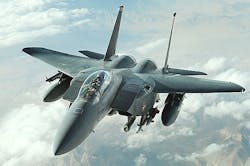Boeing wins half-billion-dollar order to upgrade radar on Air Force F-15C/D and F-15E combat jets
WRIGHT-PATTERSON AFB, Ohio, 1 Dec. 2016. Jet fighter experts at the Boeing Co. will upgrade 71 U.S. Air Force F-15 combat jets with new radar under terms of a half-billion-dollar order announced Wednesday.
Officials of the Air Force Life Cycle Management Center at Wright-Patterson Air Force Base, Ohio, awarded a $558.5 million contract modification to the Boeing Defense, Space & Security segment in St. Louis to install the upgraded radar systems on Air Force F-15C/D jet fighters, and F-15E fighter-bombers.
Boeing, the original manufacturer of the F-15C/D and F-15E combat jets, will install the Raytheon APG-63(V)3 radar on 42 F-15C/D jet fighters, and the Raytheon AN/APG-82 radar systems on 28 F-15E fighter-bombers under terms of the contract.
The F-15, designed by Boeing predecessor McDonnell Douglas Corp., is a twin-engine, all-weather tactical air-superiority jet fighter. It was designed in the late 1960s and first version of the aircraft entered service in 1976. The F-15E is a ground-attack version of the original F-15 that first entered service in 1989.
The First Air Force F-15E to receive the AN/APG-82 radar upgrade made its inaugural flight in June 2014.
The Raytheon APG-63(V)3 and AN/APG-82 radar systems use active electronically scanned array (AESA) technology, which is a phased-array radar approach that can steer the radar beam without mechanically moving the radar transceiver antenna.
AESA radar use many solid-state transceivers in an antenna array. It steers the radar beam by emitting separate radio signals from each module. This kind of radar is difficult to detect over background noise and enables F-15 combat jets to broadcast powerful radar signals while still remaining somewhat stealthy.
The Raytheon APG-63(V)3 is a more modern variant of the company's APG-63(V)2, and applies the same kind of AESA technology that Raytheon uses in the company's APG-79 designed for the Navy Boeing F/A-18 Hornet fighter-bomber. The APG-63(V)3 has been in service since 2006.
The Raytheon AN/APG-83 radar for the F-15E, meanwhile, combines the processor of the APG-79 radar with the antenna of the APG-63(V)3 AESA being on the F-15C/D. This radar upgrade is part of the F-15E Radar Modernization Program. (RMP). The new radar includes a wideband radome that enables the radar array to operate on more radar frequencies, and has improvements to environmental control and electronic warfare (EW) systems.
On this contract Boeing will do the work in St. Louis and should be finished by early 2019. For more information contact Boeing Defense, Space & Security online at www.boeing.com/defense, or the Air Force Life Cycle Management Center at www.wpafb.af.mil/aflcmc.
Learn more: search the Aerospace & Defense Buyer's Guide for companies, new products, press releases, and videos

